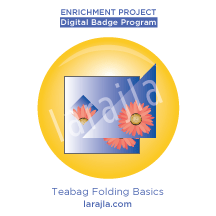 Teabag folding is also known as miniature kaleidoscope origami. Originally, squares of patterned paper were folded and assembled to create a kaleidoscope effect. This is where we will begin our journey into teabag folding.
Teabag folding is also known as miniature kaleidoscope origami. Originally, squares of patterned paper were folded and assembled to create a kaleidoscope effect. This is where we will begin our journey into teabag folding.
Steps
1. History.
Teabag folding is a relatively new paper craft. It originated in Holland. Find out about the story of Tiny van der Plaas and how looking at materials in a new way can lead to something new.
2. Tea bag envelopes.
The first folded shapes were done with tea bag envelopes. Find out about what tea bag envelopes are available to you. Can you collect enough to start folding?
3. Equipment.
The equipment you need is very basic. Collect these items from around your house.
- Cutting mat
- Metal-edged ruler
- Craft knife
- Bone folder
- Paper adhesive / double-sided tape
NOTE: You can replace the cutting mat, ruler and knife with a cutter that has all these features. Depending on the model, having a light beneath the board can be beneficial.
4. Tea bag paper.
You can purchase teabag folding papers or use patterned paper, including gift wrap. You need to be sure that each square looks exactly the same. This will give the kaleidoscope effect. Look for paper you can use for teabag folding.
The biggest issue you’ll have with your paper is where you will use it. If you intend on placing your item into a scrapbook or other media that requires archival materials, you will need to purchase pre-printed or blank paper with this in mind. Most gift wrap papers are not archival.
5. Find tea bag squares / sheets online.
You can find free squares and sheets online. Do a search online to find a design / color you like and print it out. Make sure you have multiple squares of the same size.
NOTE: This badge has a supplement sheet, SUPP_GSTeabag.pdf, with a sheet and sample medallion.
6. Tips.
Here are a few tips before you start folding. Find additional tips online.
- Cut square as straight as possible
- Crease folds with bone folder for sharper edges
- Make sure you fold the squares the same way
- Runny glue will make your paper wrinkle
- If your squares aren’t perfect, do a bit of trimming after folding
7. Start folding!
There are many ways to fold squares. Start with the five folds on the Enrichment Project supplement, SUPP_TeabagFolding.pdf. Check the links below or do a bit of surfing and find one that looks interesting to you. Fold a square and determine if you like the look.
8. Medallions / rosettes.
To create a medallion, you’ll typically need eight (8) squares of paper. They look best when the eight squares are identical. If you plan to place your completed medallion on a card, your square sizes should be between 1.5 and 2 inches. When assembling, some people like to do one at a time, others will do a set of two or three and allow them to dry before putting them together. Find what works best for you.
NOTE: Some patterns require a different number of squares.
9. Frames.
Frames are similar to medallions, except instead of making the pieces adjoin snugly at the center, you slide them out a bit, making the inside circle larger. Create a frame from your folded squares. You can use more than eight to make a larger frame.
10. Adding more variety.
You can adapt your basic teabag square with special scissors to give the outside edge a more “rugged look” or add a gem to the center of your medallion to hide the hole. Explore ways to adjust a basic teabag folded element with embellishments, creative edging and more.
11. Usage.
You can put your teabag folded items on cards, invitations, scrapbook pages, or give away as gifts. I’ve used them to embellish artistic trading cards and standard frames as well. Experiment and find more ways you can use this technique.
NOTE: If you plan on using these in a scrapbook, be sure to use archival products.
12. Ornaments.
Add a string to the medallion in Step 8 create an ornament. You can add a special button, photo or other item to the center of your medallion to make it more personal. You can also use a frame (Step 9) to place photos into your ornaments.
13. Moving beyond.
To help advertise my first teabag folding class, I took 12-inch pieces of scrapbook paper and made a medallion. I placed clockworks on it and created a teabag folded clock. Though this craft is based on small items, don’t let it stop your experimenting.
.
Supplement
.
Sites to Explore
- www.cardinspirations.co.uk/section.php/428/1/an_introduction_to_tea_bag_folding
- www.craftsitedirectory.com/craft/card-making/tea-bag-folding
- britton.disted.camosun.bc.ca/teabag/teabag.htm
- mystudio3d.tripod.com/teabagnewfold.htm
- www.squidoo.com/teabagfolding
- crafting.squidoo.com/linkstoteabagfolding
- www.ehow.com/info_8657436_tea-bag-folding-crafts.html
- www.lilystubbs.co.nz/tips.html
- www.circleofcrafters.com/teabagfolding/gallery.html
- zrosemarie.50webs.com
- www.scrapbookscrapbook.com/tea-bag-folding-instructions.html
- www.lilystubbs.co.nz/Lily%20Stubbs%20diagrams.htm
Leave a Reply